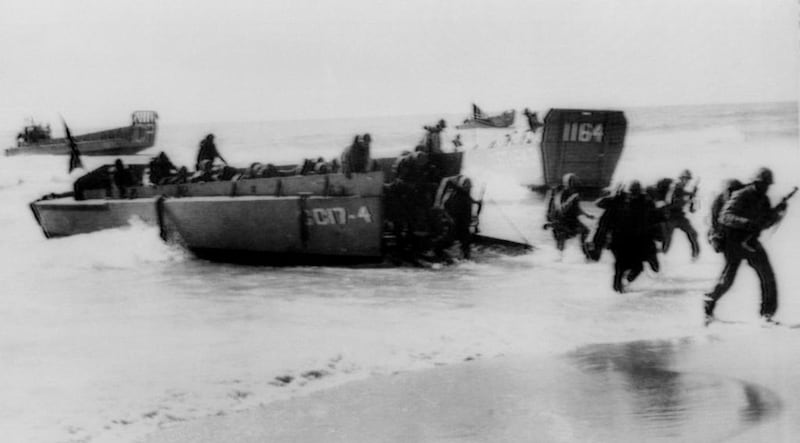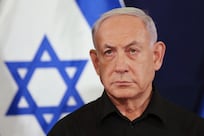As the first wave of armed US Marines hit a beach south of Beirut on July 15, 1958, the scenes made for one of the more curious foreign interventions in American military history.
Bikini-clad sunbathers rose to their feet and nearby villagers arrived on horseback as Lebanese boys rushed towards the water’s edge to help the American invaders drag their heavy equipment through the surf.
Dickey Chapelle, a veteran US war correspondent, was present during the third wave of Marine assault landings. She later wrote of the rumoured order offered up to the young invading leathernecks. “‘You will make every effort in this assault not to disturb the swimmers on the beach …’ a juxtaposition of ideas that surely had not occurred in Marine history.”
This was the first overt US military intervention in the Middle East. It happened after Lebanon’s Maronite Christian president Camille Chamoun – fearful that the Pan-Arabist ideals of Egyptian president Gamal Abdel Nasser, whose ties to the Soviet Union were disquieting the West, would engulf a restive Lebanese republic – invoked the Eisenhower Doctrine. The 1957 doctrine, launched by the US president Dwight D Eisenhower 60 years ago this month, promised American military or economic aid to any Middle Eastern country threatened by the forces of international communism. The main target, of course, was the Soviet Union itself.
In scenes reminiscent of today, the period around the emergence of the Eisenhower Doctrine witnessed Syria at the centre of a Middle East regional tug of war. By the summer of 1957, Eisenhower, concerned that Syria was drifting towards the clutches of Soviet Russia, had made two failed attempts to topple the Syrian regime by way of CIA-inspired coups. The US president then attempted to incite surrounding Arab nations to invade Syria by using the American spy agency to provoke violent disorder along the country’s borders. Turkey, then, as now, became involved in the Arab region as it massed thousands of troops along the Syrian-Turkish border. As it transpired, the leading protagonists, which included the Soviet Union, backed down and the United States was spared from being dragged into a potentially bloody regional conflict.
It was, however, the doctrine’s direct application to the Lebanese crisis that surely set the stage for future American interventions in the region of which the 2003 invasion of Iraq was its shameful nadir.
In February 1958, Egypt and Syria formed the United Arab Republic (UAR). Nasser was the darling of the Arab world and many Sunni Muslims in Lebanon called for the former French mandate’s inclusion in the UAR. Civil strife – fuelled by claims that Chamoun wished to amend the Lebanese constitution to extend his term in office – spread as rival factions clashed. The bloody murder of Iraq’s pro-western king and prime minister during a coup on July 14 proved a terror too far for Chamoun and his appeal for help led Eisenhower to dispatch his troops into the midsummer heat of the Lebanese capital.
Many US veterans who were present during the intervention recall a bewildering campaign – from the moment of arrival until the American withdrawal three months later when Chamoun was replaced as head of state and Lebanon’s first civil conflict fizzled out. During this time, thousands of US military personnel were present in Lebanon, but the nation departed the Levant almost casualty-free.
As events made clear, Lebanon’s internal fracas had little to do with the stirrings of international communism or a UAR takeover. And while Eisenhower walked away from Lebanon satisfied at a job well done, the die was cast. The American experience in 1950s Lebanon, while comparatively serene, demonstrated a US willingness to adopt overt military interventionism in the Middle East and gave the Arab world a reason to think about the country as an imperialist power – a notion that still lingers for many in the region. It also almost certainly led to the fatal impression that the Lebanese were not serious warmongers. America’s disastrous involvement in Lebanon’s bloody 1975-90 civil war, when 241 US service personnel were killed in a suicide truck bomb attack in Beirut in 1983, made for a brutal reality check.
It is also an irony that 60 years after the Eisenhower Doctrine pledged to disabuse Soviet Russia of any thoughts of Arab regional dominance, (non-communist) Russia today finds itself a serious regional power player at the heart of the Syrian conflict – currently at the expense of the US. Eisenhower would surely not approve.
Alasdair Soussi is a freelance journalist, who has worked across Africa, Europe and the Middle East
On Twitter: @AlasdairSoussi





